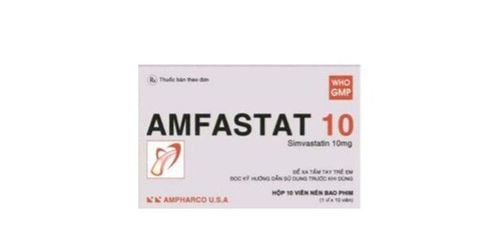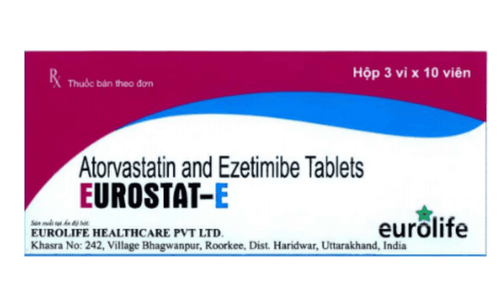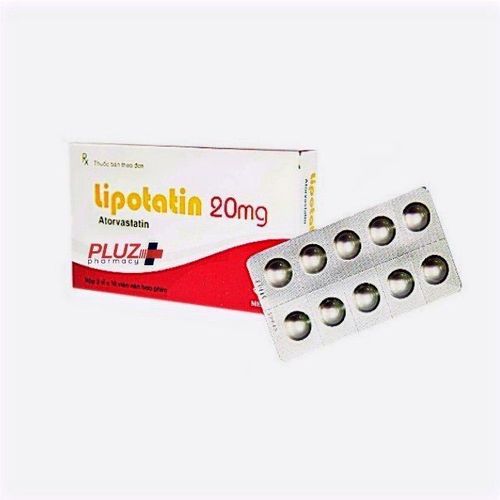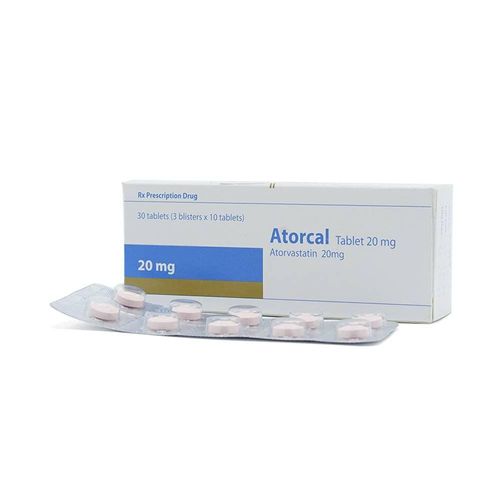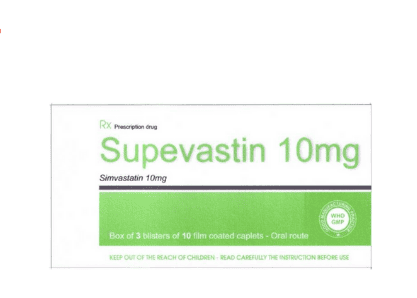This is an automatically translated article.
Silvasten belongs to the group of cardiovascular drugs, made in the form of tablets, packing box of 4 blisters x 7 tablets. It is effective in the treatment of primary hypercholesterolemia and homozygous familial hypercholesterolemia (HoFH). Learn some information about uses, dosage and precautions when using Silvasten to help patients use the drug safely and effectively.
1. Ingredients of the drug Silvasten
Each Silvasten tablet contains the following ingredients:
Simvastatin 20mg; Ezetimibe 10mg. Excipients: Cellactose 80, talc, croscarmellose sodium, silicon dioxide and magnesium stearate.
2. What are the effects of Silvasten?
Silvasten is a prescription drug, effective in the treatment of the following conditions:
Primary hypercholesterolemia Silvasten is used to reduce total cholesterol, low-density lipoprotein cholesterol (LDL-C), apolipoprotein (Apo B) , triglycerides (TG) and non-high-density lipoprotein cholesterol (non-HDL-C); elevated high-density lipoprotein cholesterol (HDL-C) in patients with primary hypercholesterolemia or mixed hyperlipidemia.
Homozygous familial hypercholesterolemia (HoFH) Silvasten is indicated for the reduction of total cholesterol and low-density lipoprotein cholesterol in patients with homozygous familial hypercholesterolemia as an adjunct to other therapies. other cholesterol-lowering agents or when no other therapy is available.
3. Dosage - How to take Silvasten
How to take Silvasten:
Silvasten is taken orally once a day in the evening. The drug is not affected by food, so it can be taken before or after a meal. Do not break or crush the tablet before taking it. During treatment, the patient should continue to follow a low cholesterol diet. Reference dose of Silvasten:
Adults:
The usual dose of Silvasten is 1 tablet/day. The dose of Silvasten should be individualized based on plasma lipid levels. Treatment should be initiated with the lowest effective dose of Silvasten and then, if necessary, adjusted according to individual patient needs and response by increasing the dose at intervals of not less than 4 weeks and should be followed. response monitoring. The starting dose of Silvasten is usually 10mg or 20mg/day, increased after 4 weeks if necessary, to a maximum daily dose of 80mg. Elderly:
No dose adjustment of Silvasten is required in these patients. Children:
Children ≥ 10 years of age, the dose of Silvasten should be adjusted individually, the usual starting dose is 10mg/day, up to a maximum of 40mg/day. Children < 10 years: Silvasten is not recommended because of limited safety and efficacy data. Patients with hepatic impairment:
No dose adjustment is required in patients with mild hepatic impairment. Do not use Silvasten in patients with moderate and severe hepatic impairment Patients with renal impairment:
No dose adjustment is required in patients with mild renal impairment (glomerular filtration rate ≥ 60mL/min/1.73m2). In patients with chronic renal failure and GFR < 60 mL/min/1.73 m2, the recommended dose of Silvasten is 1 tablet once daily in the evening. Silvasten in combination with Amiodarone, Amlodipine, Ranolazine: Do not use more than 20mg simvastatin/day.
Concomitant use with Lomitapid: Do not exceed 40mg Simvastatin when co-administered with Lomitapid.
Note: The above dose of Silvasten is for reference only. The specific dose of Silvasten depends on the condition and the progression of the disease. To get the right dose of Silvasten, you need to consult with your doctor or healthcare professional.
4. Contraindications to use Silvasten
Patients with hypersensitivity to Simvastatin, Ezetimibe or any ingredient of Silvasten. Pregnant or lactating women. Patients with advanced liver disease or persistent but unexplained elevations in serum transaminases. Contraindications to combination Silvasten with strong inhibitors of CYP3A4 such as Itraconazole, Voriconazole, Erythromycin, Ketoconazole, Posaconazole, Clarithromycin, Telithromycin, HIV protease inhibitors such as Nelfinavir; Boceprevir, Gemfibrozil, Cyclosporin, Telaprevir, Nefazodon, Danazol and drugs containing Cobicistat. Do not combine with Verapamil, Diltiazem and Dronedaron. Do not use Silvasten more than 40mg when co-administered with Lomitapid. Contraindications are absolute. This means that for any reason, Silvasten can be used in cases of contraindications. Any decision about the dose and method of taking Silvasten should be made according to the doctor's prescription.
5. Side effects of the drug Silvasten
Common side effects:
Increased ALT and/or AST, blood CK. Uncommon side effects:
Hyperbilirubinemia, serum uric acid, gamma-glutamyltransferase, INR and proteinuria; Weight loss; Dizziness with headache; Abdominal pain, indigestion, flatulence, nausea and vomiting; Rash, hives, itching; Joint pain, muscle weakness, skeletal muscle discomfort; Weakness, fatigue; Peripheral edema; Sleep disorders; Experience after bringing Silvasten to market:
Thrombocytopenia, anemia; Peripheral neuropathy, memory impairment; Cough, shortness of breath, interstitial lung disease; Constipation, pancreatitis, gastritis; Alopecia, erythema multiforme, hypersensitivity reactions including rash, urticaria, anaphylactic reactions, angioedema; Cramps, myopathy, rhabdomyolysis with or without acute renal failure, tendon disease, sometimes complicated tendon rupture, immune-mediated necrotizing myopathy; Decreased appetite; Hot flashes, increased blood pressure; Hepatitis/jaundice; Liver failure; Gallstones; Cholecystitis; Erectile dysfunction; Depression, insomnia; Increased alkaline phosphatase; Abnormal liver function; Rarely angioedema, lupus-like syndrome, polymyalgia rheumatica, polymyositis, vasculitis, photosensitivity, fever, flushing, dyspnea and fatigue; Cognitive impairment such as memory loss, forgetfulness, memory impairment, confusion; Increased HbA1c and fasting blood glucose; Sexual dysfunction; Diabetes. Silvasten may cause other unwanted effects. It is necessary to closely monitor and advise patients to inform their doctor about unwanted effects encountered during the use of the drug.
To avoid unwanted interactions when using Silvasten, patients should inform their doctor/pharmacist of all medicines, dietary supplements, vitamins and herbs... that are being prescribed. suitable application.
The basic information about Silvasten in the above article is for reference only. Because Silvasten is a prescription drug, patients should not use it on their own, but need to contact a specialist directly for a suitable prescription to ensure safety for health.





